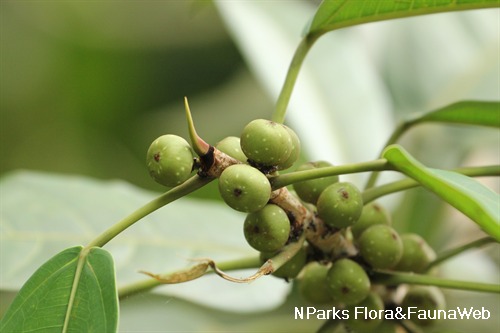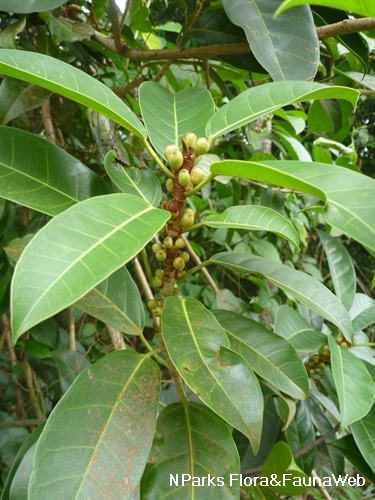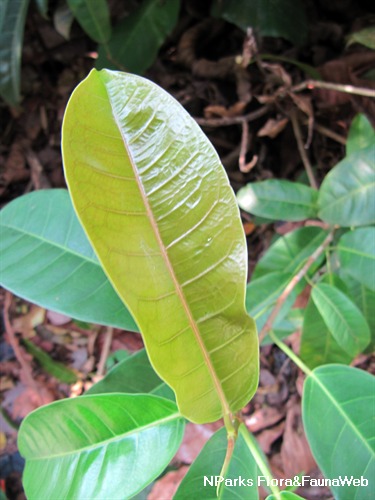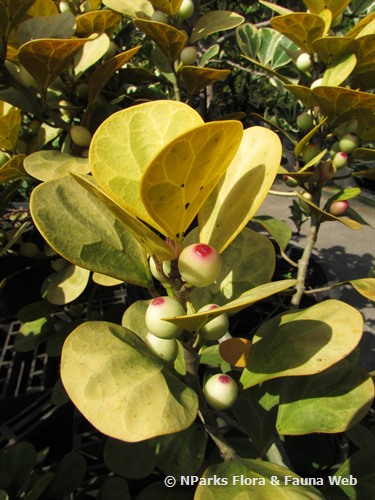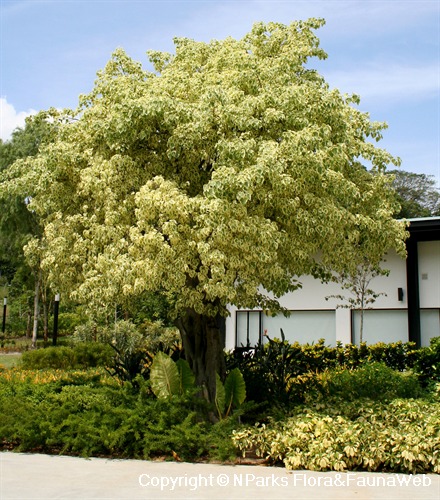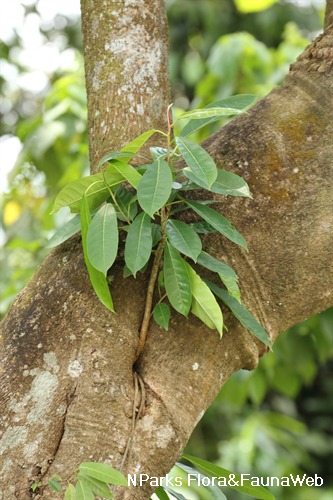
Name
Classifications and Characteristics
| Plant Division | Angiosperms (Flowering Seed Plants) (Dicotyledon) |
|---|---|
| Plant Growth Form | Climber, Shrub |
| Lifespan (in Singapore) | Perennial |
| Mode of Nutrition | Autotrophic |
| Plant Shape | Irregular |
| Maximum Height | 6 m to 15 m |
Biogeography
| Native Distribution | Myanmar, Thailand, Sumatra, Peninsular Malaysia, Singapore, Borneo, and Java |
|---|---|
| Native Habitat | Terrestrial |
| Preferred Climate Zone | Tropical |
| Local Conservation Status | Native to Singapore (Vulnerable (VU)) |
Description and Ethnobotany
| Growth Form | It is a climber or hemi-epiphytic shrub, and contains white latex. |
|---|---|
| Foliage | Its spirally arranged, long-stalked leaves have leathery leaf blades that are oblong to oval, glossy green with cream midrib and side veins, pointed-tipped, and 5–26 by 2–11 cm. |
| Flowers | The plant is monoecious. Its male, female and gall flowers are found within the same syconium (fig). The flowers are tiny and develop within the syconium (fig). |
| Fruit | Its syconia (figs) are ellipsoid to somewhat round, greenish with tiny white spots, 1.2–1.5 cm across, covered with fine, dark brown hair, and usually occur in pairs at the leaf axils or on the bare portions of twigs just behind the leaves. |
| Habitat | It grows in lowland and hill forests, which include secondary forests, along rivers, in swamps, and mangroves forests, up to 1,200 m altitude. It occurs locally in the Central Catchment Nature Reserve. |
| Associated Fauna | Its flowers are pollinated by fig-wasps. Its ripe figs attract bats and birds. It is also the preferred local food plant for caterpillars of the butterfly, striped blue crow (Euploea mulciber). |
| Cultivation | It can be propagated by seed, stem cutting or air-layering. |
| Etymology | Latin Ficus, the commercial edible fig (Ficus carica); Latin globosa, round, referring to its round syconia (figs) |
Landscaping Features
| Landscaping | It attracts bats and birds when it fruits, and is suitable for planting along roads or in coastal areas as it can tolerate hot, sunny, dry, windy, and frequent salt spray conditions. |
|---|---|
| Desirable Plant Features | Ornamental Fruits |
| Landscape Uses | General, Suitable for Roadsides, Parks & Gardens, Small Gardens, Coastal |
Fauna, Pollination and Dispersal
| Fauna Pollination Dispersal Associated Fauna | Bird-Attracting (Fruits), Caterpillar Moth Food Plant |
|---|---|
| Pollination Method(s) | Biotic (Fauna) |
| Seed or Spore Dispersal | Biotic (Fauna) |
Plant Care and Propagation
| Light Preference | Full Sun, Semi-Shade |
|---|---|
| Water Preference | Moderate Water |
| Plant Growth Rate | Moderate |
| Rootzone Tolerance | Moist Soils, Well-Drained Soils |
| Propagation Method | Seed, Stem Cutting (Softwood) |
Image Repository
Others
| Master ID | 29873 |
|---|---|
| Species ID | 4182 |
| Flora Disclaimer | The information in this website has been compiled from reliable sources, such as reference works on medicinal plants. It is not a substitute for medical advice or treatment and NParks does not purport to provide any medical advice. Readers should always consult his/her physician before using or consuming a plant for medicinal purposes. |

